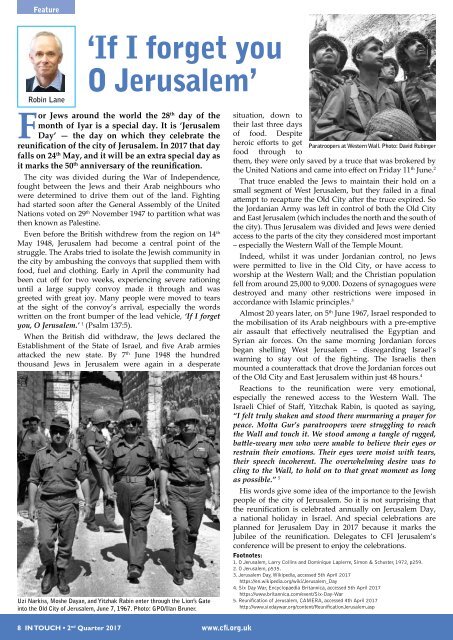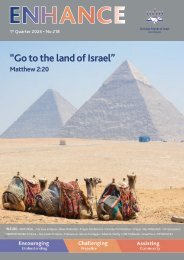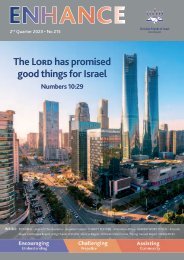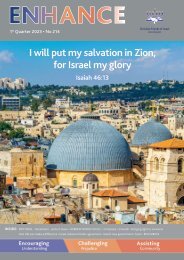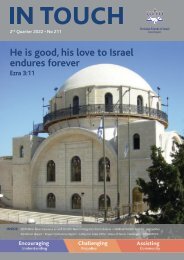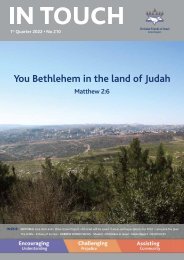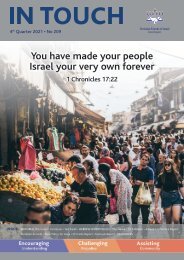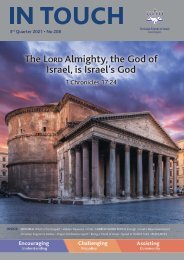Create successful ePaper yourself
Turn your PDF publications into a flip-book with our unique Google optimized e-Paper software.
Feature<br />
‘If I forget you<br />
O Jerusalem’<br />
Robin Lane<br />
For Jews around the world the 28 th day of the<br />
month of Iyar is a special day. It is ‘Jerusalem<br />
Day’ — the day on which they celebrate the<br />
reunification of the city of Jerusalem. <strong>In</strong> <strong>2017</strong> that day<br />
falls on 24 th May, and it will be an extra special day as<br />
it marks the 50 th anniversary of the reunification.<br />
The city was divided during the War of <strong>In</strong>dependence,<br />
fought between the Jews and their Arab neighbours who<br />
were determined to drive them out of the land. Fighting<br />
had started soon after the General Assembly of the United<br />
Nations voted on 29 th November 1947 to partition what was<br />
then known as Palestine.<br />
Even before the British withdrew from the region on 14 th<br />
May 1948, Jerusalem had become a central point of the<br />
struggle. The Arabs tried to isolate the Jewish community in<br />
the city by ambushing the convoys that supplied them with<br />
food, fuel and clothing. Early in April the community had<br />
been cut off for two weeks, experiencing severe rationing<br />
until a large supply convoy made it through and was<br />
greeted with great joy. Many people were moved to tears<br />
at the sight of the convoy’s arrival, especially the words<br />
written on the front bumper of the lead vehicle, ‘If I forget<br />
you, O Jerusalem.’ 1 (Psalm 137:5).<br />
When the British did withdraw, the Jews declared the<br />
Establishment of the State of Israel, and five Arab armies<br />
attacked the new state. By 7 th June 1948 the hundred<br />
thousand Jews in Jerusalem were again in a desperate<br />
Uzi Narkiss, Moshe Dayan, and Yitzhak Rabin enter through the Lion’s Gate<br />
into the Old City of Jerusalem, June 7, 1967. Photo: GPO/Ilan Bruner.<br />
situation, down to<br />
their last three days<br />
of food. Despite<br />
heroic efforts to get<br />
Paratroopers at Western Wall. Photo: David Rubinger<br />
food through to<br />
them, they were only saved by a truce that was brokered by<br />
the United Nations and came into effect on Friday 11 th June. 2<br />
That truce enabled the Jews to maintain their hold on a<br />
small segment of West Jerusalem, but they failed in a final<br />
attempt to recapture the Old City after the truce expired. So<br />
the Jordanian Army was left in control of both the Old City<br />
and East Jerusalem (which includes the north and the south of<br />
the city). Thus Jerusalem was divided and Jews were denied<br />
access to the parts of the city they considered most important<br />
– especially the Western Wall of the Temple Mount.<br />
<strong>In</strong>deed, whilst it was under Jordanian control, no Jews<br />
were permitted to live in the Old City, or have access to<br />
worship at the Western Wall; and the Christian population<br />
fell from around 25,000 to 9,000. Dozens of synagogues were<br />
destroyed and many other restrictions were imposed in<br />
accordance with Islamic principles. 3<br />
Almost 20 years later, on 5 th June 1967, Israel responded to<br />
the mobilisation of its Arab neighbours with a pre-emptive<br />
air assault that effectively neutralised the Egyptian and<br />
Syrian air forces. On the same morning Jordanian forces<br />
began shelling West Jerusalem – disregarding Israel’s<br />
warning to stay out of the fighting. The Israelis then<br />
mounted a counterattack that drove the Jordanian forces out<br />
of the Old City and East Jerusalem within just 48 hours. 4<br />
Reactions to the reunification were very emotional,<br />
especially the renewed access to the Western Wall. The<br />
Israeli Chief of Staff, Yitzchak Rabin, is quoted as saying,<br />
“I felt truly shaken and stood there murmuring a prayer for<br />
peace. Motta Gur’s paratroopers were struggling to reach<br />
the Wall and touch it. We stood among a tangle of rugged,<br />
battle-weary men who were unable to believe their eyes or<br />
restrain their emotions. Their eyes were moist with tears,<br />
their speech incoherent. The overwhelming desire was to<br />
cling to the Wall, to hold on to that great moment as long<br />
as possible.” 5<br />
His words give some idea of the importance to the Jewish<br />
people of the city of Jerusalem. So it is not surprising that<br />
the reunification is celebrated annually on Jerusalem Day,<br />
a national holiday in Israel. And special celebrations are<br />
planned for Jerusalem Day in <strong>2017</strong> because it marks the<br />
Jubilee of the reunification. Delegates to CFI Jerusalem’s<br />
conference will be present to enjoy the celebrations.<br />
Footnotes:<br />
1. O Jerusalem, Larry Collins and Dominique Lapierre, Simon & Schuster, 1972, p259.<br />
2. O Jerusalem, p535.<br />
3. Jerusalem Day, Wikipedia, accessed 5th April <strong>2017</strong><br />
https://en.wikipedia.org/wiki/Jerusalem_Day<br />
4. Six Day War, Encyclopaedia Britannica, accessed 5th April <strong>2017</strong><br />
https://www.britannica.com/event/Six-Day-War<br />
5. Reunification of Jerusalem, CAMERA, accessed 4th April <strong>2017</strong><br />
http://www.sixdaywar.org/content/ReunificationJerusalem.asp<br />
8 IN TOUCH • 2 nd <strong>Quarter</strong> <strong>2017</strong> www.cfi.org.uk


